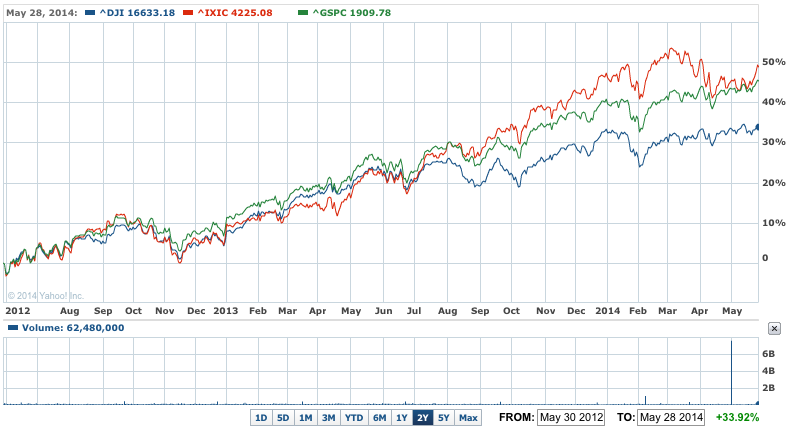New highs for Wall Street this morning, so it’s no wonder the MSCI World Index is also at new all time highs.
It was in fact the 13th record high for the key Standard & Poor’s 500 index this year.
As US shares make up 54% of the MSCI World Index, it’s no surprise the world’s major global stockmarket benchmark is in record territory.
Also helping lift the index has been six year highs for the major European sharemarkets.
The MSCI World Index is made up of large- and mid-cap stocks across 23 developed-market nations, along with a similar index from the Financial Times group, it is the leading global measure of stockmarket performance.
The performance of markets this month has made a mockery of the old adage "sell in May and go away".
Instead our market is up in May, and so are markets in Europe (Spain!), and in Asia – India’s market is up 8% thanks to the new government, but the China exposed Hong Kong market has climbed 4%, which belies the flow of weak economic news and rising levels of fear among western analysts.
Australia is up more than 2% and that includes the sell off in the first 10 days to two weeks, plus the confidence sapping federal budget which hasn’t impacted investor confidence so far.
US markets are also higher, despite a 6% plus fall in early May.
US Markets 2Y – The Dow marches on

But market volumes have been light and that’s starting to cause more worry for market analysts who fret that equities are not actually as solid as the records might suggest.
That sentiment is back by US bonds – the 10 year security closed with a yield of around 2.46%, up from the 2.40% new 2013 low hit during trading overnight.
Bond yields fell to the low of 2.40%, but then rose sharply to the higher close – it was a second day of volatile trading in the huge US bond market – which sits oddly with the moderating conditions in sharemarkets in particular.
But one of two analysts are starting to wonder what will happen to US share prices once the Federal reserve stops its stimulatory spending in October.
They see big falls – one analysts suggested overnight the plunge could be of the order of 15% to 20%, once the Fed stops buying.
US investors overnight ignored data showing the economy contracted by an annual 1% in the March quarter and focused instead on better-than-expected jobless claims and a takeover battle developing deal news in the food industry.
The contraction was driven mostly by the fall out from the very severe winter, especially in January and February across the US Midwest and north eastern states.
Analysts at Citigroup reckon the economy will rebound strongly in the current quarter to an annual rate of 4%, and Goldman Sachs wasn’t far behind with a 3.9% call.
The Standard & Poor’s 500 index bounded higher at the close and finished at its intraday record level, up 10.25 points, or 0.5%, to 1,920.03.
The Dow added 65.56 points, or 0.4%, to 16,698.74, and the tech heavy Nasdaq index jumped nearly 23 points to close at 4,247.95.
European markets ended mostly higher, but Asian markets were lower.
The Aussie dollar was trading close to 93 US cents this morning after the better than expected business investment data yesterday.
Gold fell $US5 an ounce to $US1,256, but oil rose to $US103.50.
The share price futures contract has our market up around 10 points at the opening later this morning.













